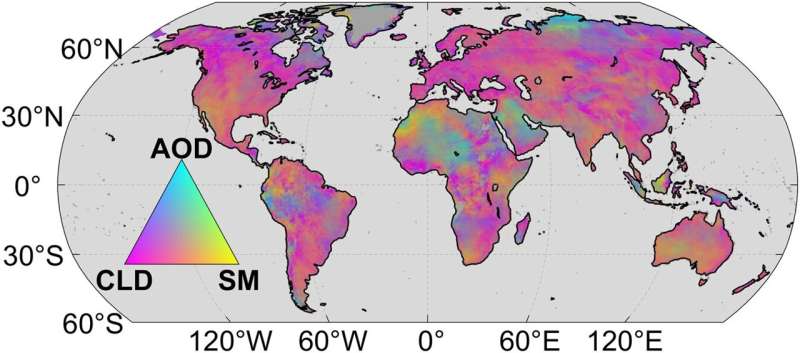This article has been reviewed according to Science X's editorial process and policies. Editors have highlighted the following attributes while ensuring the content's credibility:
fact-checked
peer-reviewed publication
trusted source
proofread
Increased temperature difference between day and night could affect all life on Earth, say scientists

Researchers from Chalmers University of Technology, in Sweden, have discovered a change in what scientists already knew about global warming dynamics. It had been widely accepted since the 1950s that global temperature rises were not consistent throughout the day and night, with greater nighttime warming being observed.
However, a recent study reveals a shift in dynamics: with greater daytime warming taking place since the 1990s. This shift means that the temperature difference between day and night is widening, potentially affecting all life on Earth.
The rise in the global average surface temperature is one of the key characteristics of human-induced climate change. However, the temperature increase is not uniform throughout the day and night, and nighttime temperatures have increased at a faster pace than daytime temperatures in the latter half of the twentieth century. This warming pattern, with variations between day and night is termed "asymmetric warming" and could be due to both human activities and naturally occurring phenomena.
In a study, titled "Reversed asymmetric warming of sub-diurnal temperature over land during recent decades," published in Nature Communications, an international team of researchers reinvestigated the asymmetric warming phenomenon and found that the pattern has reversed.
Between 1961 and 2020, global daytime warming has accelerated, while the warming rate of nighttime temperature is relatively constant. This reversed trend in asymmetric warming has led to an increasing temperature difference between day and night.
"We initially aimed to confirm the previously observed phenomenon of nighttime warming surpassing daytime warming. To our surprise, not only had the asymmetric warming trend ceased, but our analyses, based on state-of-the-art observation-based datasets, indicate a complete reversal of this original warming pattern over the past three decades," says Ziqian Zhong, post-doctoral researcher at Chalmers.
Global brightening a potential cause
"A likely explanation to this change is a phenomenon called 'global brightening," which has been observed since the late 1980s. It is a result of less cloud cover, which causes more sunlight to reach the Earth's surface, leading to higher daytime temperatures and, as a result, a broader difference between daytime and nighttime temperatures over the recent decades," says Ziqian Zhong.
There is currently significant uncertainty regarding the reasons behind the changes in cloud cover. The "global brightening" may be attributed to a complex interplay between cloud-free and cloudy atmospheres, as well as the effect of small particles in the atmosphere, known as aerosols. These aerosols can be derived from natural processes like sea spray and wildfires, but also from human activities like fossil fuel burning, and they can have a profound effect on many aspects of the environment.
Apart from the effects from global brightening, the researchers suggest another reason for the reversed asymmetric warming. The increase in regional drought events and heat waves suggests a potential weakening of the cooling effect due to evaporation at the Earth's surface, which would typically result in a faster increase in daytime temperatures.
The researchers found that the majority of land, 81% of the total area, experienced larger nighttime warming from 1961 to 1990. However, in the subsequent period from 1991 to 2020, a shift occurred, with 70% of the observed land areas experiencing larger daytime warming instead.
Affecting all life on Earth
The larger temperature difference between day and night could potentially affect crop yields, plant growth, animal well-being and human health.
For example, an increased temperature difference between daytime and nighttime is recognized as one of the environmental stressors that could lead to elevated heart rate and blood pressure, consequently increasing cardiac workload and the mortality and morbidity of cardiovascular and respiratory diseases.
"This indicates the need to adjust strategies in different areas affected by temperature variations between day and night, such as agriculture, public health, and forestry management, to address the challenges posed by this climate change," says Ziqian Zhong.
Certain tree species in humid areas might enhance their carbon sequestration capacity due to the increased temperature difference between daytime and nighttime. However, the increased temperature difference between daytime and nighttime might prove disadvantageous for trees in dry regions, as higher daytime temperatures may increase evaporation, leading to deficiency of soil water and unfavorable conditions for tree growth.
"In the upcoming research, we will further investigate the impacts of this reversed trend in asymmetric warming on tree growth and carbon cycle," says Ziqian Zhong.
More information: Ziqian Zhong et al, Reversed asymmetric warming of sub-diurnal temperature over land during recent decades, Nature Communications (2023). DOI: 10.1038/s41467-023-43007-6
Journal information: Nature Communications
Provided by Chalmers University of Technology




















